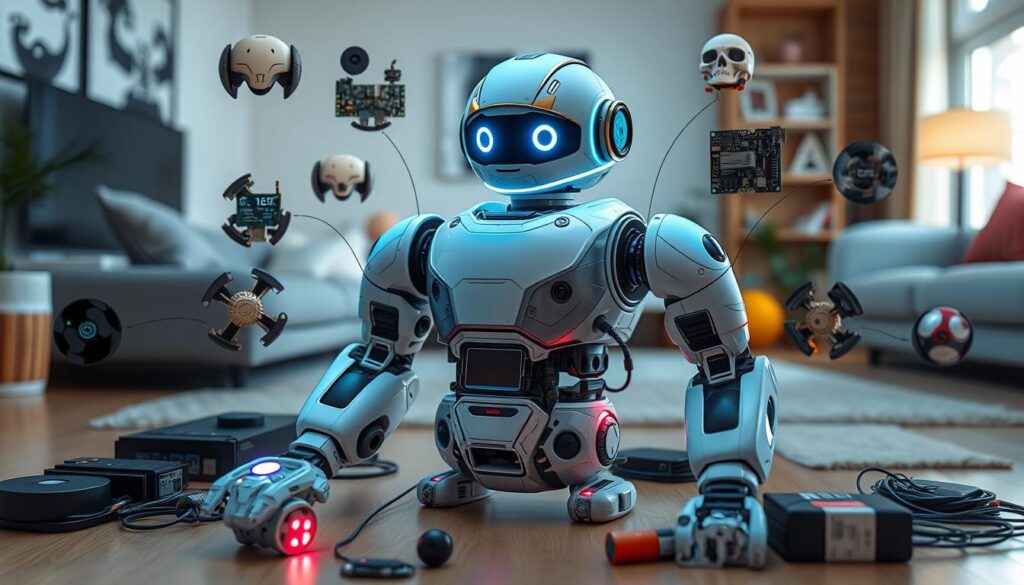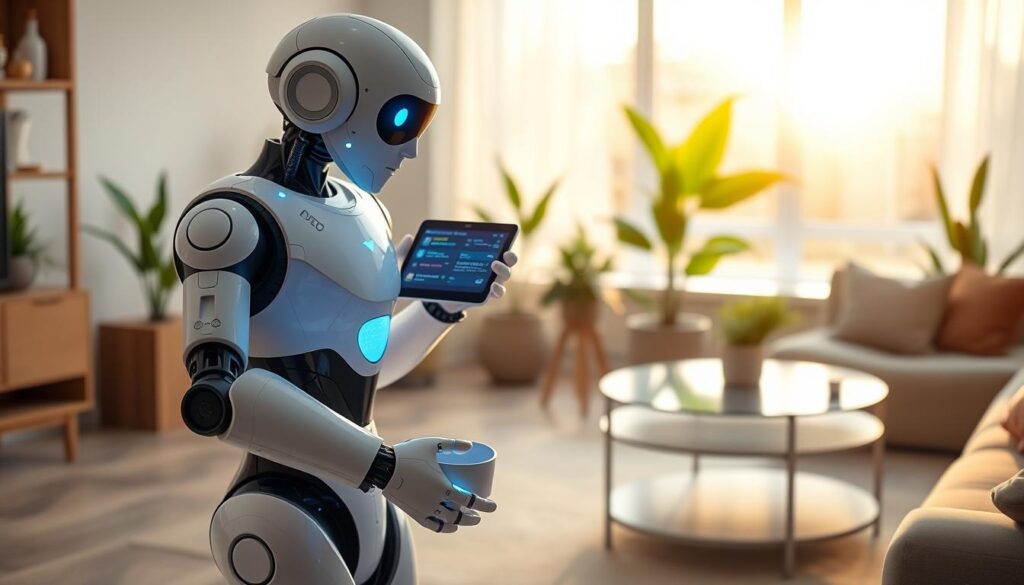Home robots are getting better and more affordable in the 21st century. They help with tasks like cleaning and security. They also entertain and help with our health.
These robots use advanced sensors and AI to work well. They can move around and understand their surroundings.
Artificial intelligence and machine learning have changed home robots a lot. They can learn and improve our lives. This makes home robots smarter and more helpful.
Robot engineering has made huge progress. It’s thanks to the hard work of researchers and tech companies. They keep making home robots better and more useful.
The Evolution of Home Robotics
The story of robotics is truly captivating. It started with simple industrial robots in the 1960s. Now, we have robots that can understand and interact with their surroundings. The first robots were used in factories to do hard work. Later, computers and better electronics helped robots do more complex tasks.
From Industrial Beginnings to Domestic Assistants
The big change came with artificial intelligence (AI) and machine learning. These technologies let robots learn and make decisions on their own. This made them better at handling complex tasks. Now, domestic robots can move around homes and talk to people in new ways.
The Rise of Artificial Intelligence and Machine Learning
The growth of computer and robotic intelligence has been amazing. The first robots were in factories in the 1960s. Early home robots in the 1980s and 1990s were simple. But, with AI and machine learning, home robots can now learn and adapt in smart ways.
| Year | Milestone | Description |
|---|---|---|
| 1959 | Unimate | The first industrial robotic arm deployed, capable of storing a program of up to 200 movements in its memory, transforming the auto industry into a realm of widespread automation. |
| 1969 | Stanford Arm | The first small, electric-powered six-axis robot, weighing only 15 pounds and featuring six degrees of freedom, designed by Victor Scheinman. |
| 1972 | Shakey | The first robot to use artificial intelligence, capable of building a model of its environment and generating plans to achieve goals by observing and reacting to the world around it. |
Key Components of Home Robots
The home robotics industry is growing fast. Home robots now have advanced sensors, cameras, and AI algorithms. These help them move around, see their surroundings, and do tasks.
Sensors and Cameras for Navigation and Perception
Home robots have many sensors like cameras, lidar, sonar, and infrared. These sensors help them see and move around the home. They map out the space, find obstacles, and avoid hitting things.
The Dobb·E robot is a great example. It’s small, weighing just 23 kilograms. It uses advanced sensors to move and do tasks on its own for up to two hours.
Advanced Algorithms and AI-Driven Software
Sophisticated algorithms and AI software are key for home robots. They let the robots learn, adapt, and make smart choices. This software helps them understand their surroundings, follow commands, and do tasks well.
The HoNY dataset is a big help for these robots. It has lots of data from 22 homes. Companies like Nvidia and Qualcomm also make special chips for these robots. These chips help the robots run their advanced software smoothly.
The Moley Robotic Kitchen is a great example. It has two robotic arms that can cook like a human. It uses AI to learn and do complex cooking tasks all by itself.

Roles and Applications of Home Robots
Home robots are changing how we do household tasks. They help with cleaning, security, entertainment, and even healthcare. These smart machines are making our homes better.
Cleaning and Maintenance Tasks
Robotic vacuum cleaners and mops are now common. They use sensors and algorithms to clean our homes. For example, the Roomba vacuum has sold millions, showing how much people want automated cleaning.
Security and Surveillance
Home robots with cameras and sensors improve home security. Companies like Deep Sentinel are making AI-powered security robots. Anki Vector can patrol and alert homeowners, adding extra protection.
Entertainment and Companionship
Social robots entertain and interact with us. Anki’s Cozmo robot, for example, sold 2.5 million units in 2017. The market for entertainment robots is growing fast, expected to hit $7.5 billion by 2020.
Healthcare and Personal Well-being
Home robots help with healthcare too. Robots like NAO remind us to take medicine and guide exercise. In surgeries, robots help doctors, showing their role in healthcare.
The U.S. service robot market is worth $5.2 billion, with home robots expected to add $11 billion by 2020. Home robots are set to change our lives, making our homes safer, more fun, and healthier.
Home robot development
The world of home robotics is changing fast. Researchers and engineers are exploring new ideas in domestic automation. A team at Carnegie Mellon University’s Department of Mechanical Engineering has worked with Google DeepMind and the University of Washington. They created a unique robot called LocoMan.
LocoMan is a versatile robot for the home. It can help with many tasks. It has robotic arms on its front legs to open doors, pour drinks, and clean up after kids. It works with humans to make daily life easier.
This robot is different from humanoid robots, which are complex and expensive. LocoMan shows how robots can work together with people. As home robot development grows, we’ll see more robots like LocoMan that are designed for humans.
The use of household robots is just starting. But the demand is growing. Companies like Amazon and Dyson are investing in smart home robotics and automated home solutions.
But making residential robotic assistants is hard. Robots struggle with complex tasks that people find easy. They need to get better at navigating, handling objects, and understanding daily life.
Despite the challenges, the future of domestic automation and intelligent home robotics is bright. As we keep pushing the limits, we’ll see robots that make our lives better. They will add comfort, convenience, and well-being to our homes.
Popular Home Robot Categories
Home automation and robotics are growing fast. This has led to many types of robots for homes. The most sought-after include robot vacuums and mops, robot window cleaners, and social and companion robots.
Robot Vacuums and Mops
Robotic vacuum cleaners, like the Roomba series and Ecovacs Deebot, are common in homes. They use smart sensors and algorithms to clean floors well. They can go around furniture and obstacles. Some can even mop, making cleaning easier.
Robot Window Cleaners
Window-cleaning robots are also popular. The Ecovacs WINBOT is one example. It cleans windows without streaks. It sticks to the glass and moves across, cleaning without help.
Social and Companion Robots
Social and companion robots are made to talk and interact with us. Anki’s Vector is an example. It talks, reminds you of things, and even keeps you company. It uses AI and machine learning for a better experience.
As home robotics grow, these types show how tech is changing our lives. They make home tasks easier and improve our living spaces.
Factors to Consider When Choosing a Home Robot
Choosing a home robot involves several important factors. Needs analysis and budgeting, smart home ecosystem compatibility, and brand reputation and customer support are key. These elements greatly affect your decision and how you’ll use the robot.
Needs Analysis and Budgeting
First, think about what you need from a robot. Will it clean, keep you safe, or be a friend? Next, decide how much you can spend. Knowing your needs and budget helps you find the right robot for you.
Smart Home Ecosystem Compatibility
Check if the robot works well with your smart home. Good integration means easier control and automation. Make sure the robot can work with your other smart devices and services.
Brand Reputation and Customer Support
Look into the brand and model of the robot you’re interested in. Read reviews and check customer feedback. A well-known brand with good support means a better experience in the long run.
By looking at these factors, you can choose a robot that fits your needs and budget. It should also work well with your smart home and come from a trusted brand.

Conclusion
The world of home robots has changed a lot. Thanks to home robot development, robotic systems for homes, and domestic automation, our homes are now smarter. What started as simple machines has turned into advanced, AI-powered domestic assistants.
Today, home robots can do many tasks for us. They use sensors, cameras, and smart software to understand and move around our homes. This makes our lives better.
The demand for home service robots and residential robotic assistants is rising. This means we’re on the verge of a new era. Soon, smart home robotics and automated home solutions will be a big part of our lives. It’s an exciting time for intelligent home robotics.

